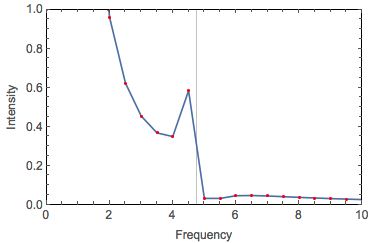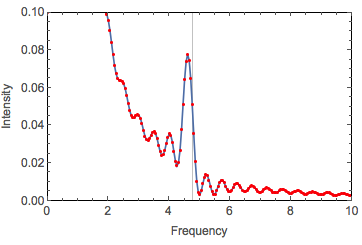I have a signal that I want to identify the frequencies in it, I used the Fourier function but I can't get the frequency correctly. Here is a simplified example:
dt = 1/100;
ls = Table[0.1 Cos[30 x] + 2 Sin[x]^2, {x, 0, 200 dt, dt}];
ListPlot[ls, Mesh -> All, MeshStyle -> Red]

and the Fourier transform
ListPlot[Abs[Fourier[ls]]^2, PlotRange -> {{0, 10}, {0, 1}},
DataRange -> {0, 1/dt},
FrameLabel -> {"Frequency", "Intensity"},
Mesh -> All, MeshStyle -> Red, GridLines -> {{30/(2 π)}, None}]

Why do I get the peak not at the original frequency 30/(2Pi), but with a frequency shift? Did I make a terrible mistake? What's the correct way to recover the original frequency using Mathematica's signal processing features?
I tried to padding zeros but still have a frequency shift.
ListPlot[Abs[Fourier[PadRight[ls, 2000]]]^2,
PlotRange -> {{0, 10}, {0, .1}}, DataRange -> {0, 1/dt},
FrameLabel -> {"Frequency (eV)", "Fourier transform (arb.)"},
Mesh -> All, MeshStyle -> Red, GridLines -> {{30/(2 π)}, None}]

